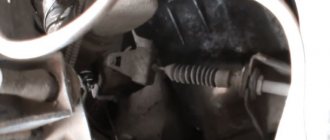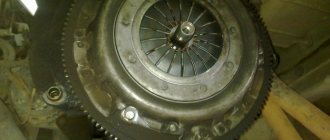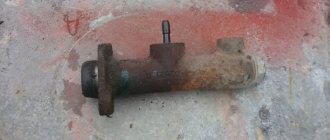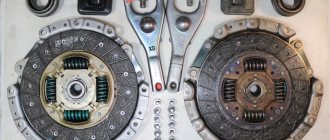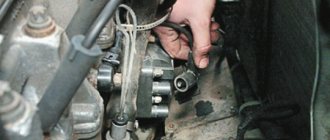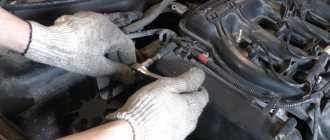On all cars produced by the Russian automaker AvtoVAZ, including the most popular model in our country, the Lada Priora, the clutch is activated thanks to a mechanism called a clutch cable. This special mechanism is very important in the car control system and is sometimes called a clutch. Those car owners who prefer to carry out replacements and repairs in the car in a timely manner and with their own hands will be interested in studying this material, in which we will tell you about this device and how the clutch cable is replaced and other nuances.
About working on the clutch cable on LADA Priora
Initially, on domestic passenger VAZs with a rear-wheel drive system, the clutch was engaged thanks to an ordinary hydraulic system. The principle is exactly the same as that of the brake drive: all the pressure from the main cylinder is supplied to the so-called working cylinder. Only modern cars, such as, for example, the Lada Priora we are considering, received a front-wheel drive system; the specialists of the automobile manufacturer abandoned this principle of operation of the device in question, which greatly facilitated maintenance. The company has developed a reliable and very simple system for engaging a car clutch using a cable, now it is the main one in the entire system. The principle of the rocker arm, so to speak, is applied here, that is, when pressing the lower part of the corresponding pedal while sitting in the car, its working part, located at the top, passing through the rod (the so-called base), certainly begins to go in a completely different direction, plus everything else at this time she pulls the cable straight and, of course, behind her.
The second end of the cable is located on the drive fork of the clutch system. When the pedal is pressed, the clutch is released, thus directly enabling shift/on. transfer.
Automatic tension cable
The design of the clutch cable with automatic tension differs from the usual one only in the tip attached to the pedal. Otherwise, the entire structure remains unchanged. Installation of a tip with auto tension first appeared in 2007 on the Lada Priora. Subsequently, such a cable was borrowed by Niva, Grant, Kalina and Vesta cars.
The principle of operation of such a tip is based on a ratcheting mechanism; over time, when the cable is stretched, the spring of the tip automatically jumps over the “tooth” on the ratchet mechanism, thereby producing tension.
This design principle allows the car owner not to resort to adjustments for a very long time.
The cost of the cable in stores starts from 400 rubles and above, depending on the manufacturer and store.
Flaws
The main disadvantage of the cable is the increased noise level. According to reviews from owners of cars with an automatic clutch tension adjustment mechanism, the cable can make cracking and grinding noises when pressing the pedal.
Correctly adjusting the cable or replacing it with a new one will help get rid of this symptom.
Clutch cable device in Priora
In order for the drive to work properly and stably, the core (cable) is located inside a special casing, completely fixedly fixed. As mentioned above, one end of the cable is attached to the clutch fork, as you understand, on the gearbox, and the other end is located in the cabin near the pedal. Each end is equipped with a fastening device. The ends are very different from each other, and it is simply impossible to confuse them in any way. There is also a rubber coupling; it is installed in the body in the hole where the cable goes into the compartment where the engine is located from the car interior.
So, the device consists of the following elements:
- In duplicate, fasteners for the casing.
- Clutch cable.
- Fastening element for fork.
- There is a special loop for the pedal.
- Rubber casing to protect the interior opening.
As you already understand, the core is located inside a hard shell, where it moves under the influence of return springs and the pedal itself. Thanks to this, its stable operation is ensured.
Priora diagnostic connector
Priora doesn't start well when hot
Removal process
First of all, you will need to dismantle the air filter:
- remove the cable itself, using a leash to remove it from the fork of the drive that disengages the clutch;
- using 17 keys (2 pieces), partially unscrew the two nuts holding its shell on the gearbox crater bracket and pull it out;
- under the dashboard, located directly in the car interior, tighten the nut with an 8mm wrench from the pedal itself.
Access is hampered on one side by the engine compartment partition, and on the other by the lower edge of the instrument panel. The work space is significantly limited. But performing the required operation is quite simple - using a flat-head screwdriver that fits the length.
It will be much more difficult to remove the staple. To make it easier to operate, the pedal is raised as high as possible. Ideally, the bracket should appear above the opening. The main thing is to remove the fastening from the cable itself. In the future, it is easy to put on the bracket either using pliers with long lips, or from the side of the power unit with your hands.
Next you will need:
- remove the expansion tank of the engine cooling system;
- dismantle the thermal insulation of the engine on the left side;
- Unscrew the bolts and remove the fastening brackets holding the rubber boot in place (both on the left and on the right) and remove it completely;
- Using a screwdriver, carefully remove the retaining bracket from the fastening axis of the cable guide;
- the latter, in turn, is removed from the foot drive finger.
It is important not to lose the plastic sleeve installed there. Without it, the cable cannot be attached
If it becomes unusable, you need to put a new one on your finger.
Finally, all that remains is to pull out the mat holders (there are 2 of them). This must be done carefully, since they are plastic and break easily.
After this, you need to remove the rubber cover installed in the partition of the engine compartment and finally pull out the damaged cable.
What are the main faults in the Priora clutch cable?
When the clutch cable on a Lada Priora is already in a state close to failure, or even possibly has failed, the driver will immediately feel it. When an attempt is made to engage the clutch in order to shift or engage a gear. Main types of breakdowns:
- The drive fastener to the pedal or probably the fork is broken. Always at such a moment the pedal will fall to the floor.
- The cable is disheveled. In this case, it is almost impossible to press the clutch pedal.
- The cable has broken. In this case, the pedal also falls freely.
All this indicates that it is time to conduct a thorough check of the drive on the Lada Priora. Each of the above malfunctions indicates that the clutch cable needs to be replaced and everything can be done even with your own hands. There is no point in replacing individual parts.
If you need to service your all-wheel drive, then you need to contact specialists and they will carry out preventive work for you; a car with all-wheel drive requires constant monitoring of the units.
Features of clutch adjustment
Vehicles Lada Priora, Kalina and Granta are equipped with clutch cables equipped with ratcheting devices. By their design, the cables are backlash-free, so their adjustment is theoretically not necessary, but in fact, the manufacturer recommends that car owners periodically adjust the device.
To correctly adjust the cable on Lada Kalina, Priora and Granta cars, prepare a screwdriver and a ruler (or caliper) and follow these steps:
First you need to open the hood, after which the cable should be installed in its original position. To do this, you need to move the lower part of the cable a little forward, that is, in the direction of its movement, this must be done until it stops. When moving the cable, you may feel a slight force on the return spring; this should not scare you.
Next, using a ruler or caliper, you should measure the distance. Which one is shown in the photo, you need to mark the distance from the beginning of the fork to the cable lead. To do this correctly, you must also hold the cable and fix it in one position. Take a measurement, ideally it should be 2.7 cm, but of course, if you are faced with the need to adjust on a Lada Priora, Kalina or Grant, then this distance will be either larger or smaller. Therefore, you should bring it to the required parameter; to do this, you need to rotate the cable lead in one direction or the other.
After these steps, you will need to insert the tip of the cable into the groove of the fork, then the element itself can be released
Please note that there should be no gap at all.
In general, the cable adjustment procedure is completed. Now you only need to press the pedal a few times to make sure everything is working properly
After several presses, measure the distance on the cable again; if necessary, adjust the device again.
No matter how new the clutch is, the owners of Lad Prior, Grant and Kalin periodically need to make adjustments to the pedals.
The need for adjustment may occur when:
- constant jerking when starting to move;
- the appearance of shocks when trying to turn on one or another speed;
- sinking of the pedal itself.
These symptoms indicate that the pedal needs to be adjusted correctly. Ideally, the clutch pedal should be located at the same level as the brake - then the full stroke should be about 12.5-13.5 cm, but in practice this figure can be increased to 16 cm. To correctly adjust the pedal, prepare two wrenches of the appropriate sizes.
- Using a wrench, loosen the cable lock nut, which is installed in the engine compartment.
- Next, you need to use another wrench to start tightening the second locknut, so you can correctly set the required gap. When the process is complete, the first locknut should be tightened until it stops.
Please note that if you set the pedal so that it is lower than the brake, then the grabbing will appear when the pedal just leaves the floor. Accordingly, if the brake pedal is lower, then the clutch will occur almost at the end. Ideally, these two pedals should be located at the same level (video by Time R).
Changing the clutch cable on a Priora
As we said, replacing the clutch cable in your LADA Priora is possible with your own hands, the most important thing is to know how to change it correctly. Read more about this.
To replace you will need the following tools:
- The keys are ordinary 8“/17“.
- Pliers/screwdriver/pry bar.
The replacement begins with dismantling the old drive, and you need to start from the interior of the LADA Priora. You will have to do everything with an assistant. Algorithm of actions:
- Slowly release the clutch fork. In this case, an assistant removes the cable fastening bracket from the pedal.
- Unscrew the fastening of the casing near the pedal. Use key 8 for this.
- Let's move on to the engine compartment, and using a screwdriver you should carefully pull out the seal there and pull the cable out there.
- We disconnect the negative terminal of the battery, since the work will be carried out next to the starter drive.
- Remove the air filter. Access to the cable fastening is now open.
- Using a 17 key, we easily release the shell latch. Thus, the core will be weakened and the tip in the fork at the point where the clutch is engaged can be freely removed.
- Remove the casing from the groove. This is all that is required for the drive to become free.
- Let's go to the salon. Let's start installing the new device. At this stage, the assistant must pull the cable from the engine compartment into the passenger compartment. Before starting installation, lubricate all open areas of fastening the tips and the core itself.
- We place it properly in the cabin, secure the tip mechanism, of course, to the pedal.
- Attach the casing.
- We press out the fork and attach the clamp directly to the fork.
- We put it in the place where the casing is supposed to be fastened, directly on the gearbox. Using a 17 key, we adjust the tension of the device in question.
- We fix the seal that was previously removed from there in a special hole in the passenger compartment.
- We put a device such as a car air filter in its rightful place.
Step-by-step instructions for replacing the clutch
First you need to remove the gearbox (see removing the gearbox)
1. In order to maintain balancing during installation, mark the position of the disk housing in relation to the flywheel (see gallery below).
2. Find a hole in the clutch pressure plate and mount a mandrel there. If suddenly you don’t have a mandrel, you can dismantle it without it, you just need to hold the clutch driven disc when removing it.
3. Unscrew and remove the 6 bolts that connect the flywheel and the clutch pressure plate housing. Using a screwdriver, try to fix the flywheel without allowing it to rotate. When you tighten the bolts during installation, do it gradually, moving from one bolt to another and making no more than one turn of the wrench at a time.
4. Dismantle the clutch housing with the pressure plate.
5. The driven disk is dismantled together with the mandrel.
6. Check the condition of the driven disk and replace it if you notice the following defects:
• presence of cracks on its parts; • the rivet heads are recessed by less than 2 millimeters and the rivet joints are weakened; • the surface of the friction linings is oily; • damper springs in the hub sockets are broken or loose; • disc runout exceeds 0.5 millimeters; • visible warping of the disk has been detected.
7. Carefully examine the surface where the friction of the pressure plate and flywheel occurs. If visible signs of wear, overheating, deep scratches, nicks and scuffs are detected, we replace the defective components.
8. Check the condition of the pressure plate. If the following defects are present, replace it:
• cracks on the disc spring; • in places where there is contact between the clutch release bearing and the spring petals, visible wear is noticeable; • the contact points between the clutch release bearing and the spring petals are located in different planes.
9. Inspect the compression spring support rings. The presence of signs of wear and cracks is unacceptable; in this case, the pressure plate assembly will have to be replaced.
10. Before installing the clutch, it is necessary to check the rotation of the driven disk along the splines of the gearbox input shaft. If there is any jamming, remove it or replace the defective parts.
11
When installing the driven disk into the pressure plate housing, make sure that the protruding hub part is directed towards the pressure spring.. 12
The driven disk is installed using a mandrel.
12. The driven disk is installed using a mandrel.
13. When installing the pressure plate housing, place the part on the three alignment pins, screw in and tighten the bolts that secure the housing and flywheel together (evenly from one bolt to the other, no more than one turn per pass).
14. We take out the mandrel.
15. Install the gearbox.
16. We adjust the clutch, not forgetting to install its lower end on the gearbox.
At this point, the replacement of the clutch on the Priora is completed, road tests can be carried out sovetyavto.ru
Lada Priora sedan 2008, engine Gasoline 1.6 liter., 98 hp, Front drive, Manual - DIY
Comments 12
Does water enter the interior after replacing the cable?
No. Dry in the cabin.
Hello! Your Priora is clear. Question? About the inclusion of the first and second - the same bullshit. Here on the road they advised me to change the top cushion (guitar) and it will pass. Looking under the hood I found that mine was completely dead. I changed it! No results. I drove it at 100 I was thinking about adjusting the link (I was told that everything was fine with it) By the way, I have a “short-throw” one. Sometimes it sticks in the first time, but usually I have a hard time hitting it very hard (but without crunches) What can you tell me. Did you resolve the issue?
Hello. Thank you))) I haven’t decided anything yet. After a while, the gearshift lever began to dangle like shit and finally could not turn the first and second. I adjusted the rocker, it seems more or less, but the lever still dangles. Next week I plan to remove the box, an autopsy will show what's wrong there. I'll write it in the blog.
I also have 1st and 2nd gears that are stuck, I went to a car dealership and they said that I need to adjust the traction
As soon as I didn’t install this slide, I tried making cuts on it and bending it so that the stroke would be straight (I have a short stroke). I'll try to install a stock one of these days, but it won't help. We called a friend of ours, a motorsports engineer, and he said that most likely the selection mechanism, there is some kind of crap that is bending and the gears are starting to engage slowly. It only takes a couple of times, I don’t want to stick it in, and this crap bends. They strengthen it in motorsport. If manipulating the switch doesn't help, I'll open the gearbox and see what's wrong. Regarding the chassis, I’m thinking of mailing the GP 4.1 and changing the 2nd gear with a different gear ratio, so that there wouldn’t be such a big drop in speed between the first and second, for a more comfortable ride.
I can’t find the time, a relative works in a car service center and said that the traction needs to be adjusted, I need to go and show it
I'm sure nothing will help me other than opening the box. Because there were shafts, a short slide, it all affected the checkpoint, I pushed it a little. When you get there, write back if it doesn’t bother you.
How to install
Before installing a new cable, you need to thoroughly lubricate both the bushing and pin on the pedals. The plastic composition Litol-24 is best suited for this.
Then the end of the cable is threaded into a hole located in the bulkhead of the engine compartment on the passenger compartment side of the car so that it ends up in the engine compartment. The rubber cover is also tucked in there.
The gear tip driver is put directly onto the clutch drive pin and secured with a bracket.
The end of the shell is secured with a nut to the pedal bracket. Make sure that the fixation is secure. It is unlikely that anyone will like to, if something happens, climb there again due to a poor-quality connection.
Next, under the hood, the lower part of the shell is stuck into a special hole on the gearbox bracket.
The leash is screwed onto the end of the cable (there is a thread there) - the latter should protrude approximately one turn outward, but no more.
Now comes the time to adjust the clutch drive. Upon completion of this process, the pedal is pressed all the way two or three times and then the setting is repeated.
The working surface of the tip driver must be treated with the above-mentioned lubricant.
All that remains is to make sure that the entire mechanism is now working properly and install all previously removed parts in place.
You can learn more about the process in the video below:
Removal, replacement, installation of the crankshaft and its bearings
Symptoms: the clutch pedal has moved to its lowest position, the free play of the clutch pedal has increased.
Possible cause: Clutch drive cable is damaged.
Tools: socket set, wrench set, flat screwdriver, solid oil.
1. In the car interior, under the dashboard, unscrew the fastening nut of the clutch cable support to the pedal bracket using an 8-mm wrench. Remove the stop from the bracket.
2. Disconnect the locking bracket and the housing of the driven disc lining wear compensation mechanism from the clutch pedal pin (use a screwdriver).
3. Remove the plastic bushing from the pedal pin. Inspect the bushing for wear and, if present, replace the bushing after applying grease to it.
4. Remove the clutch release cable seal from the hole in the front panel (in the engine compartment of the car).
5. Pull the tip of the cable in the direction of straight-line movement of the car, and then remove it from the groove located on the clutch release fork.
6. Unscrew the fastening nut of the cable end to the bracket on the gearbox using a 17mm wrench. Prevent the cable end from turning by holding it with a second wrench.
7. Remove the cable end from the slot in the bracket, and then pull the cable out of the hole in the front panel.
8. Remove the clutch cable from the vehicle.
9. To install a new clutch drive cable, first pass it through the hole in the front panel, and then fasten the housing of the driven disc lining wear compensation mechanism to the clutch pedal pin.
Note. Before installing the wear compensation mechanism on the clutch pedal pin, lubricate the pin bushing with grease.
10. Fix the cable sheath stop on the pedal bracket.
11. Install the sealing element of the clutch cable sheath into the slot in the front panel.
12. Install the cable end into the gearbox bracket, and then tighten the cable nut.
13. Screw the driver onto the lower tip of the clutch drive cable so that the tip protrudes relative to the driver end to a height of 0 - 1 mm.
14. Install the clutch release cable to its original position as follows:
– move the lower tip of the drive cable all the way forward in the direction of straight-line movement of the vehicle;
– hold the tip in an extended position;
– measure dimension L (the distance between the clutch release fork and the driver). The distance L should be 27 millimeters;
– if the permissible value does not correspond, set it by rotating the leash in the desired direction.
15. Insert the end of the drive cable into the groove located on the clutch release fork, and then release it. The leash must be installed on the fork without play under the action of a spring.
Note. Before installing the tip guide on the clutch release fork, lubricate its surface that contacts the fork with grease.
16. Depress the clutch pedal all the way three times, then measure distance L again (see point 14).
17. Repeat the adjustment if necessary.
Malfunctions and their symptoms in the clutch drive of front-wheel drive VAZs
If the clutch cable is in poor condition, or has already failed, this is immediately noticeable when you try to engage the clutch to operate the gearbox. The most common breakdowns are:
- break of the cable itself;
- ruffling of the clutch core body;
- failure of the drive fastener to the fork or pedal.
If the fastener or cable breaks, the pedal falls freely, and if the core becomes ruffled, on the contrary, pressing becomes very difficult. If these signs appear, it is necessary to urgently check the drive.
Do-it-yourself VAZ clutch adjustment
In principle, adjusting the clutch of a VAZ-2107 or 2109 (2115) is practically no different, since the models have a similar design and basic parts base. To solve this problem you will need a standard set of car keys. The sequence of adjustment work on the clutch system must be performed in the following order:
Preparing the car. For easy access to the necessary parts, the machine must be installed on an overpass or above an inspection hole. This will greatly simplify access to the working cylinder pusher.
Checking the clutch system. Inside the car, you need to check the free play of the pedal. Determining this value is quite simple. To do this, you need to measure the gap between the control lever and the actuator rod. Move the pedal to its highest position, the gap should be in the range of 0.5 to 2.0 millimeters.
Pedal adjustment. If deviations are detected during measurement, adjustments must be made. Using a 10mm wrench, you need to loosen the lock nut on the travel stop. Use rotational movements to achieve the required clearance. Make adjustments gradually, with frequent measurements. After obtaining the desired value, lock the lock nut.
Checking and replacing the clutch release cable of Lada Priora
The clutch release drive is backlash-free, i.e. There are no gaps in the drive.
The drive cable is equipped with a ratchet-type mechanism to compensate for its length during operation when the driven disk linings are worn, so adjustment of the clutch drive in operation is not required.
During each maintenance, it is necessary to monitor the travel of the clutch pedal and at the same time the clarity of gear shifting.
Set the clutch release cable to its original position by overcoming the force of the mechanism spring and move the lower tip of the cable forward in the direction of vehicle movement until it stops.
Holding the tip in an extended position, measure the dimension L between the fork and the leader, it should be 27 mm.
If the size does not correspond to the specified value, set it by rotating the leash in the desired direction.
Insert the end of the cable into the groove of the clutch release fork and release it.
Under the action of the spring, the tip driver should be installed on the fork without any gap.
Before installing the tip driver on the fork, apply LSC-15 or Litol-24 lubricant to its surface in contact with the fork.
Press the clutch pedal three times all the way and measure the distance L again.
If necessary, repeat the adjustment.
The principle of operation of the flexible drive of the Priora coupling
On the first models of Russian VAZ passenger cars, with rear-wheel drive, the clutch was engaged using a hydraulic system. That is, as with the brake drive, when the pressure from the master cylinder is transmitted to the working, actuating mechanism. When developing a new series of VAZs with driving front wheels, this scheme was abandoned. A simple and reliable system for engaging the clutch mechanism using a special cable was developed. The principle of the rocker arm works here. When you press the lower part of the pedal, the upper working area, through the base (rod), goes in the opposite direction and pulls the cable along with it.
The other end of the flexible connector is attached directly to the clutch drive fork. When you press the pedal, the clutch disengages, making it possible to engage or change gear in the box.
Installing a new element
You need to start assembly from the Priora's interior, although you can only feed the cable from the engine compartment. When it is already placed in place in the cabin, attach the cable end compensation mechanism to the pedal. Attach the casing. Then, pressing the plug, secure the clamp for the plug.
Having installed the housing mount on the gearbox in place, use a 17 key to adjust the correct tension of the device.
Attach the rubber seal to the hole in the passenger compartment and replace the air filter. That's it, replacement of the flexible clutch drive is done.
In the video, the process of dismantling the Priora clutch cable:
